Abstract
The shortage of good quantity and quality of water for irrigated agriculture is a major problem in arid and semiarid regions. To deal with this problem, deficit irrigation (DI) or arbuscular mycorrhizal fungi (AMF) inoculation have been proposed and adopted for many crops as a tool to save water, or to improve crop tolerance to drought stress. An experiment was conducted for two consecutive years to evaluate the effect of mycorrhizal inoculation on the physiological, morphological, yield, and quality characteristics of melon plants grown under deficit irrigation. Melon crop (Cucumis melo L. cv. Helios) was grown under field conditions adopting a split-plot design with four replications, where DI was the main factor and AMF inoculation was the secondary factor. DI treatments consisted of applying 60%, 80%, or 100% of crop evapotranspiration (ETc) on melon plants inoculated or not with a commercial biostimulant containing 50% of Rhizophagus irregularis, and 50% of Funneliformis mosseae. Moderate and severe deficit irrigation significantly reduced the relative water content, stomatal conductance, yield, nitrogen applied efficiency (NAE), and fruit firmness of the uninoculated plants, but significantly increased irrigation water use efficiency (IWUE) and the ascorbic acid content of the fruit. AMF had a positive effect on plant tolerance to moderate water stress, and on some fruit quality parameters (fruit length, firmness, and sugar content). The combined use of moderate deficit irrigation (80%) and soil inoculation with AMF on melon plants allows water savings without affecting fruit yield, and increases IWUE, NAE, and some fruit quality characteristics (firmness, SSC, and SSC/TA). Furthermore, the use of AMF plants could be worth it to reduce the yield loss and increase fruit quality, even with severe deficit irrigation (60%).
1. Introduction
Water shortage is currently one of the biggest problems worldwide, and there is significant uncertainty around the level of water availability for future generations [1]. The increasing demand for water and the competition among household, industry, and agricultural uses make it increasingly difficult access to water resources of good quality [2,3]. The scenario is also complicated by climate changes due to global warming, which often leads to serious drought phenomena in many parts of the world and constrains more appropriate management of water resources. Irrigation water management in an era of water shortage should be conducted most efficiently, aiming at saving water and at maximizing its productivity [4]. Increasing food production to meet global food demands while ensuring sustainable use of water resources is an important goal for growers and researchers that could also be achieved by optimizing irrigation strategies [5]. A viable and sustainable production strategy in arid and semi-arid regions contemplates appropriate irrigation scheduling to save water and improve agricultural water use efficiency while also maintaining crop productivity. Excessive water use for irrigation reduces water productivity (WP) and increases input costs, thus reducing net returns [6]. Deficit irrigation (DI) is the application of a sub-optimal amount of water (below the crop evapotranspiration requirements) [7]. This irrigation technique can allow water savings but could result in yield reductions. When correctly applied, DI has successfully resulted in increasing the efficiency of water use and WP of various crops without causing severe yield reductions [8]. Nevertheless, a water deficit may represent a significant abiotic stress factor in some crops, reducing the number of fruits per plant, fruit size, and yield. At the same time, it may also result in enhanced fruit quality, and production cost limitation, and limiting water application may reduce soil leaching and groundwater pollution [9,10,11,12,13]. Thus, the appropriate DI strategy should offer significant water savings and, at the same time, provide the right balance among yield, quality, and net return [14,15,16]. The response of vegetable crops to DI may vary a lot according to the species, as each species can differently modify its physiological processes in relation to water stress intensity and when it occurs. Melon is highly sensitive to water deficits that may determine high yield loss, especially during flowering and fruit setting [17], while deficit irrigation during the ripening period does not influence fruit yield, but may improve fruit sugar content [12,17].
DI affects soil moisture determining modification of soil biological properties with a possible negative impact on microbial communities that drive essential ecosystem processes [18,19]. Changes in soil moisture can alter the abundance, activity, functional metabolic potential, mobility, and physiology of soil microbial communities [20,21,22,23,24]. Soil microbiomes have a crucial function in nutrient cycling and uptakes, and in protecting plants from soil-borne pathogens, so nutrient acquisition by crops could be largely influenced by root interactions with soil microorganisms [25,26]. These represent an important and fragile part of agricultural ecosystems, and have been applied to agricultural soil in the past few decades to increase their presence in the rhizosphere and compensate for the negative effect of some agricultural practices [27]. Among beneficial soil microorganisms, arbuscular mycorrhizal fungi (AMF) have been shown to exert positive effects on crop growth and yield under different environmental conditions by developing close symbiotic relationships with plants [28]. AMF can be considered an extension of the root system, enhancing the water and nutrient uptake capacity of the host [29,30,31]. Thus, to improve the plant performance of vegetable crops, even in the case of deficit irrigation, the presence of functionally compatible AMF is of paramount importance [27]. Many commercial microbial biostimulants containing AMF are widely available in the market, and their application to agricultural fields is rising [32]. Several experiments performed in different environmental conditions and on many crops have shown that when indigenous fungi are absent or in low levels in the rhizosphere soil inoculation with AMF can be a feasible and rewarding way to benefit plant growth and yield [27,33,34,35].
Considering this background, the objective of this paper is to test the hypothesis that soil inoculation with AMF can improve plant tolerance to water stress, thus mitigating the negative effects of deficit irrigation. Deficit irrigation or mycorrhizal inoculation has been already tested individually on melon plants, but their joined use has not been studied yet. Therefore, this research aimed at testing the effect of mycorrhizal inoculation on the physiological, morphological, yield, and quality characteristics of melon plants grown under deficit irrigation regimes.
2. Materials and Methods
2.1. Experimental Site and Climate Data
Two experiments were conducted during 2015 and 2016 from April to August at the experimental research field ‘‘Istituto agrario Castelnuovo’’ of the Department of Agricultural, Food, and Forest Sciences (SAAF—University of Palermo, Italy), situated in Palermo, Italy (38°9′23″ N 13°19′58″ E; altitude 48 m a.s.l). The soil is sandy loam (Alfisol) with a depth of about 0.70 m. Soil characteristics are provided in Table 1.

Table 1.
Soil characteristics of trial plots.
The volumetric water content for the first 0.3 m was 27.0% at full water holding capacity (soil matric potential of −0.03 MPa), and 9.9% at a soil matric potential of −1.5 MPa (permanent wilting point).
The study area has a Mediterranean climate with an average annual rainfall of 580 mm, mainly distributed from September to March, outside the growing season. During the crop cycle, the total reference evapotranspiration (ETo) was 524.4 mm in 2015, and 506.9 mm in 2016.
2.2. Crop Management, Experimental Design, and Irrigation Treatments
One of the most widespread melon (Cucumis melo var. Inodorus Naud.) hybrid cultivated in Italy, cv. ‘Helios’ (HM.Clause Italia SpA, Venaria Reale, TO, Italy), was selected for the trials. Seedlings purchased from a local commercial nursery were transplanted to the soil covered with black polyethylene mulch on 21 May 2015 and 1 May 2016, 1.0 m apart within rows, and 2.5 m apart between rows (the conventional plant density used by producers in the region). The size of each subplot was 87.5 m2, and included 35 plants. The irrigation system was composed of one drip line per row and emitters of 4 L h−1, 0.33 m apart. After the transplant, each plot received about 30 mm of water to improve seedling establishment. The experimental design adopted was a split-plot design with four replications. The experimental factors were deficit irrigation and soil inoculation with AMF. The irrigation treatment was assigned to the main plot and mycorrhizal inoculation to the subplots. In both years, irrigation (I) treatments were 60% crop evapotranspiration (ETc), 80% ETc, and 100% ETc. Half of the plants for each irrigation treatment were not inoculated (control plants), and the other half were inoculated with arbuscular mycorrhizal fungi (AMF) using a commercial formulation (Aegis Irriga, Italpollina S.p.A., Rivoli Veronese, VR, Italy) that contains 50% of Rhizophagus irregularis (previously known as Glomus intraradices), and 50% of Funneliformis mosseae (formerly Glomus mosseae). Two inoculations were performed, following the manufacturer’s recommendations: the first at transplant by pouring the suspension containing the spores of AMF into the transplant hole; the second when the plants had the first flower by pouring the suspension at the base of the plant. The suspension was distributed so as to inoculate a total of 100 spores per plant.
All treatments received the same amount of nutrient elements that were distributed through fertigation from seedling settlement to fruit growth. According to soil fertility, 180 kg ha−1 of N and 150 kg ha−1 of K2O were distributed throughout the crop. No phosphatic fertilization was performed as it can negatively affect mycorrhiza development in different plants [36,37,38].
The irrigation treatments were applied three times a week from 8 June to 28 August 2015, and from 18 May to 12 August 2006, though the irrigation regimes were calculated on a weekly basis. The weekly ETc was calculated from the equation: Crop evapotranspiration (ETc) = reference evapotranspiration (ETo) × crop coefficient (Kc) [39]. The ETo was assessed by the Penman–Monteith method [40] using daily data from a meteorological station located 100 m from the experimental field. The Cropwat 8.0 software [41] developed by FAO’s Land and Water Development division was used for ETo calculation. The crop coefficients (Kc) used during the crop seasons were chosen according to the indications provided by Cabello et al. [42].
The water doses to be supplied to each treatment were calculated as the ratio between the ETc of the previous week (net of any useful rainfall calculated using Cropwat 8.0), and the estimated efficiency coefficient of the distribution system equal to 0.81 [42]. This value was then divided by 7 to calculate the daily irrigation needs. The amount of water delivered to the plants was controlled through volumetric water meters installed at the head of the drip line of each treatment, therefore allowing to limit any difference between the amount of water distributed and that programmed.
2.3. Agronomical, Morpho-Physiological, Yield, and Quality Parameters
During plant growth, 20, 30, and 40 days after transplant (dat), the length of the main shoot of the plants was measured. After 70 dat, the water status of the plants was evaluated by calculating the relative water content (RWC). Ten leaves for each replicate (one for plant) were sampled 24 h after irrigation and immediately weighed (FW), placed in distilled water for 24 h, then their turgid weight (TW) was calculated. The turgid leaves were dried in an oven to a constant weight at 80 °C and weighed to obtain their dry weight (DW). RWC was calculated as RWC = (FW − DW)/(TW − DW) × 100 [43]. The stomatal conductance of the leaves was also measured using a porometer (Porometer AP4, Delta-T Devices, Cambridge, UK) [44]. The instrument was calibrated before each measurement and the measurements were conducted on 10 leaves for each replicate with homogeneous characteristics in terms of development, age, and exposure to light.
Fruit harvest started after 75 dat in 2015 and 79 dat in 2016 when fruits were fully mature, and lasted 17 days in 2015 and 24 days in 2016, respectively. Each melon fruit was weighed in each harvest to calculate the average fruit weight. Fruits that were cracked, with visual defects or badly misshapen, and weighed less than 1.0 kg were considered unmarketable. Fruit numbers per plant and marketable fruit yield per ha and per plant were also determined. The use efficiency of the irrigation water (IWUE) was estimated from the marketable fruit yield (kg ha−1), and the volume of water supplied (m3 ha−1) to the plants for each treatment during the crop cycles (IWUE = marketable fruit yields/water supplied) [45]. Similarly, the efficiency of the nitrogen applied (NAE) was also calculated from the marketable fruit yields (kg ha−1) and the amount of N applied (kg ha−1) (NAE = marketable fruit yields/N applied) [45].
At the end of harvesting, the root mycorrhizal colonization was evaluated for each treatment by visualizing the mycorrhizal development. Three samples of lateral roots were collected from each plant and stained with acid fuchsine. In particular, Phillips and Haymann’s technique [46], modified by Miceli et al. [27], was applied. The Mycorrhization Index was then calculated as MI = % of stained tissue, with respect to the hyaline portion, on the unit of length of the root analyzing three root fragments and determining the average value [47].
Soon after harvesting, some fruit quality parameters were determined on ten fully mature marketable fruits randomly selected for each replicate. The volume of the fruits was estimated by applying the water displacement technique. Each melon fruit was slowly glided into a known volume of water until the water completely covered the fruit, then the water displaced by the fruit was weighed. The volume of each melon was obtained with the following equation [27]: Actual volume (mL) = W/γ, where W is the weight of displaced water, and γ is the weight density of water. The water temperature was kept at 25 °C. After volume measurement, the fruits were cut longitudinally in two halves for more determinations. Fruit flesh color was measured on three points of one half of each fruit, using a colorimeter (Chroma Meter CR-400C, Minolta, Osaka, Japan) that recorded the CIELab parameters L* (lightness), a* (positive values for reddish colors and negative values for greenish colors), and b* (positive values for yellowish colors and negative values for bluish colors). Starting from these parameters, Chroma (C*) and Hue angle (H°) were calculated as C* = (a*2 + b*2)1/2 and H° = arctan(b*/a*). Flesh firmness was determined at three points of one half of each fruit along the longitudinal axis using a digital penetrometer (mod. 53205, TR Snc., Forlì, Italy) with a flat stainless steel cylinder probe of 8 mm diameter. The force necessary to penetrate the flesh to a depth of 0.5 cm was measured, and the mean peak force was expressed in Newton. Rind thickness was measured in two opposite parts on the equatorial plane of each fruit using a standard caliper. The placenta and the seeds were then removed, and the fruit’s flesh was separated from the rind and weighted to calculate the edible part percentage of each fruit. The mesocarp of each fruit was liquified, and the homogenate obtained was centrifuged at 3500 rpm for 10 min, and the supernatant was used to determine titratable acidity (TA), ascorbic acid, and soluble solid content (SSC). TA was analyzed by potentiometric titration with 0.1 M NaOH up to pH 8.1 using 10 mL of liquid extract and expressed as mg of citric acid 100 g−1 [27]. SSC (expressed as °Brix) was obtained using a digital refractometer (MTD-045nD, Three-In-One Enterprises Co., Ltd., Taiwan). Ascorbic acid content (mg 100 g−1 of fresh weight) was determined by extracting 10 mL of pulp juice in 100 mL metaphosphoric acid (HPO3). The mixture was then filtered through Whatman no. 1 filter paper and a volume of 10 mL from the filtered solution was determined volumetrically with the 2-6 dichlorophenol-indophenol reagent until a slightly pink coloration was observed and persisted for 15 s [48].
2.4. Statistics and Principal Component Analyses
To evaluate the effect of cultivation year, irrigation regime, and mycorrhizal inoculum on melon plants, a three-way ANOVA was conducted. The significance of the differences between treatments and of the interaction between factors was determined by the least significant differences (LSD) test at p ≤ 5%.
The main parameters that were most effective in discriminating among irrigation regimes and mycorrhizal inoculum in both cultivation years were evaluated by performing a principal component analysis (PCA) on morpho-physiological parameters, and yield of melon plants and fruit characteristics. The input matrix for the analysis included main shoot length, MI, RWC, stomatal conductance, yield, number of fruits per plant, IWUE, NAE, fruit weight and volume, fruit diameters, rind thickness, edible part, pulp firmness, SSC, TA, SSC/TA, ascorbic acid content, L, chroma, and hue. Only the factors with eigenvalues higher than 1.0 were used to calculate the optimum number of principal components (PCs). In addition, the plot of the PCs studied the correlation between the variables of the input data set. The examined variables were reported into the subspace defined by the first and second PCs, and the correlated variables were calculated. The principal component analysis was performed with SPSS version 13.0 (SPSS Inc., Chicago, IL, USA).
3. Results
3.1. Amount of Applied Irrigation
The temperatures and precipitations recorded during the trial periods are reported in Figure 1. The reference evapotranspiration (ETo), crop coefficients (Kc), and crop evapotranspiration (ETc) during the cultivation periods of 2015 and 2016 are reported in Figure 2, whereas the cumulated irrigation water amounts applied during 2015 and 2016 are presented in Figure 3. The scheduled irrigation treatments started at 19 dat in 2015 and 18 dat in 2016, and ended at 100 dat and 99 dat in 2015 and 2016, respectively. The ETo during the irrigation treatment period was 440.0 mm and 434.0 mm in 2015 and 2016, respectively. The ETc values ranged from 334.8 mm in 2015 to 330.3 mm in 2016. The total volume of irrigation water applied, considering also initial watering, ranged from 406.6 mm and 485.1 mm for 100% ETc to 252.0 mm and 302.3 mm for 60% ETc in 2015 and 2016, respectively.
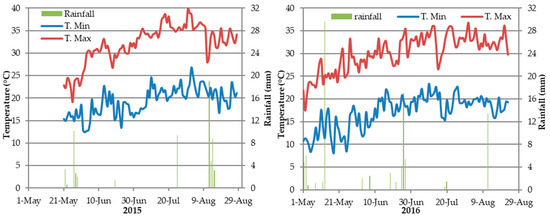
Figure 1.
Daily average maximum and minimum temperatures and rainfall during the trial periods.
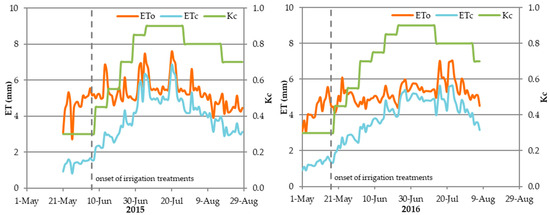
Figure 2.
Reference evapotranspiration (ETo), crop evapotranspiration (ETc), and crop coefficients (Kc) calculated and applied over the scheduling irrigation period in the two years of the experiment.
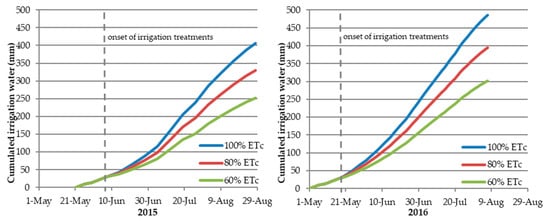
Figure 3.
Cumulated amount of irrigation water applied over the scheduling irrigation period in the two years of the experiment.
3.2. Plant Growth and Yield Components
Plant growth, and fruit production and quality showed a similar and superimposable trend during the two years of trials and no significant differences were recorded between years (Y). Moreover, the interactions between the year and irrigation treatment (I) and/or plant inoculation (M) (Y × I; Y × M; Y × I × M) and the year of the experiment was not significant according to the three-way ANOVA performed on data from the two years of trials. Thus, syntheses from the years for individual features have been presented in the results (Table 2, Table 3 and Table 4).

Table 2.
Effect of irrigation treatments and plant inoculation with arbuscular mycorrhizal fungi (AMF) on the mycorrhizal index (MI), main shoot length, leaf relative water content (RWC), and stomatal conductance of melon plants during two years of experiments.

Table 3.
Effect of irrigation treatments and plant inoculation with arbuscular mycorrhizal fungi (AMF) on yield components, irrigation water use efficiency (IWUE), and nitrogen applied efficiency (NAE) of melon plants during two years of experiments.

Table 4.
Effect of irrigation treatments and plant inoculation with arbuscular mycorrhizal fungi (AMF) on melon fruit characteristics during two years of experiments (SSC: soluble solid content; TA: titratable acidity).
Root colonization by mycorrhizal fungi occurred in all trials, even those not supplied with the commercial biostimulant. Both irrigation and soil inoculation affected the mycorrhization index and a significant interaction between the experimental factors was also found (Table 2, Figure 4). The lowest mycorrhization index was found in the roots of uninoculated melon plants with no significant differences determined by deficit irrigation (15.9%, on average). The introduction of AMF by inoculating the commercial suspension determined a significant increase in root colonization at every irrigation level, but was highest supplying 80% ETc (42.0%).
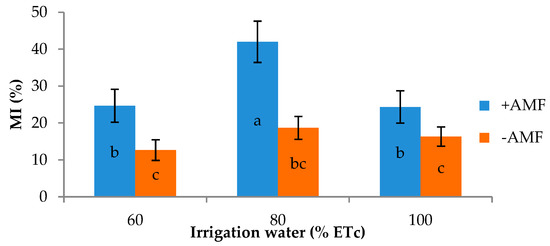
Figure 4.
Effect of irrigation treatments and plant inoculation with arbuscular mycorrhizal fungi (AMF) on the mycorrhizal index (MI) of melon plants during two years of experiments (bars with different letters are significantly different at p < 0.05 according to the LSD test).
Plant growth during forty days after transplant was little influenced by irrigation and mycorrhizal inoculation (Table 2).
The relative water content can give information on plant water status. During plant growth, this parameter was significantly influenced by deficit irrigation treatments that determined a significant reduction between 100% ETc (92.8%) and 60% ETc (89.5%) (Table 2). Inoculated plants showed a higher RWC (92.8%) than non-mycorrhized plants (89.3%). Plant water content can be influenced by water soil content and transpiration as decreasing water availability in the soil tends to cause plants to close their stomata. Stomatal conductance was effectively reduced by deficit irrigation, but with a descending trend that differed between mycorrhized and non-mycorrhized plants (Figure 5). The stomatal conductance of the unstressed plants (100% ETc) was 306.1 mmol m−2 s−1 on average and dropped by 46.6% on average (163.5 mmol m−2 s−1) in the plants irrigated with 60% ETc. With 80% ETc deficit irrigation, the inoculated plants showed a small and non-significant reduction in the stomatal conductance (−13.2%), whereas the uninoculated plants significantly reduced their stomatal conductance down to values similar to 60% ETc plants (Table 2, Figure 5).
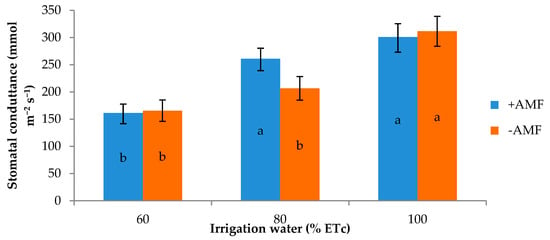
Figure 5.
Effect of irrigation treatments and plant inoculation with arbuscular mycorrhizal fungi (AMF) on the stomatal conductance of melon leaves during two years of experiments (bars with different letters are significantly different at p < 0.05 according to the LSD test).
Yield characteristics of melon plants were significantly affected, mainly by deficit irrigation, but also due to a significant interaction between soil inoculation and irrigation management (Table 3).
Under no water stress, both inoculated and uninoculated plants reached the highest total yield per plant (9.0 kg plant−1, on average). The lowest yield per plant (−20.3%) was recorded with the more severe water stress (60% ETc), whether plants were inoculated or not (7.1 kg plant−1, on average), and with the moderate water stress (80% ETc) in the uninoculated plants (7.4 kg plant−1), whereas under the same irrigation regime, inoculated plants recorded a yield per plant (9.0 kg plant−1) comparable to that of unstressed plants.
This effect was modified by considering yield per hectare, as plant mortality (5%) was recorded in non-mycorrhized plants irrigated with 60% ETc. Total yield was mainly affected by the irrigation treatments (Table 3), but a different response to deficit irrigation was found between inoculated and uninoculated plants in terms of marketable yield. This difference was due to the effect of the experimental treatments on unmarketable fruit production. The incidence of unmarketable fruits was lowest under no water stress conditions (100% ETc) in both plant treatments (3.7%, on average). Reducing the irrigation volume (80 and 60% ETc) the percentage of unmarketable yield increased up to 6.9%, on average, in the uninoculated plants, whereas it was 3.4% in the inoculated plants (Table 3). Thus, the marketable yield was highest in both plant treatments with 100% ETc (44.7 t ha−1, on average), and was not significantly reduced when reducing irrigation to 80% ETc in the mycorrhized plants (44.9 t ha−1), but dropped by 19% in the uninoculated plants and by 25.3% on average in all the plants irrigated with 60% ETc (34.1 t ha−1, on average) (Table 3, Figure 6).
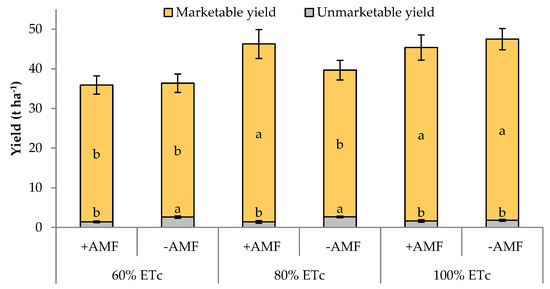
Figure 6.
Effect of irrigation treatments and plant inoculation with arbuscular mycorrhizal fungi (AMF) on marketable and unmarketable yield of melon plants during two years of experiments (bars of the same color with different letters are significantly different at p < 0.05 according to the LSD test).
The number of melon fruit harvested per plant was not significantly affected by irrigation treatments or by AMF inoculation even if it slightly decreased by reducing irrigation water (Table 3). Thus, yield variations were mainly due to the modification recorded in the average fruit weight (Table 4).
The lowest irrigation water use efficiency (IWUE) (Table 3, Figure 7) was calculated in the treatments with no water stress (100% ETc), reaching 10.2 kg m−3, on average for mycorrhized and non-mycorrhized plants. The moderate water stress (80% ETc) did not affect the IWUE of the uninoculated plants (10.4 kg m−3), but determined a significant increase (+20.9%) in the inoculated plants that recorded the highest IWUE (12.6 kg m−3). A high IWUE was also found with the highest water stress (60% ETc) in both plant treatments (12.5 kg m−3, on average).
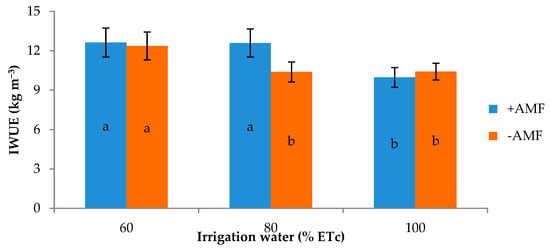
Figure 7.
Effect of irrigation treatments and plant inoculation with arbuscular mycorrhizal fungi (AMF) on irrigation water use efficiency (IWUE) of melon plants during two years of experiments (bars with different letters are significantly different at p < 0.05 according to the LSD test).
The nitrogen applied efficiency (NAE) was conditioned by the irrigation treatment (Table 3, Figure 8), the highest value (248.4 kg kg−3 N) being in the 100% ETc treatment. Water stress significantly reduced the NAE of non-mycorrhized plants grown under moderate (−17.2%) or intense (−24.5%) stress, and of mycorrhized plants grown under intense stress (−22.8%). The mycorrhized plants reacted better to moderate water stress maintaining an NAE value not significantly different from the well-watered treatments (251.1 kg kg−3 N).
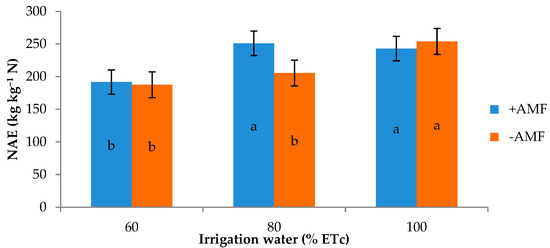
Figure 8.
Effect of irrigation treatments and plant inoculation with arbuscular mycorrhizal fungi (AMF) on nitrogen applied efficiency (NAE) of melon plants during two years of experiments (bars with different letters are significantly different at p < 0.05 according to the LSD test).
The relationship between the relative yield (yield/maximum yield) of the mycorrhized and non-mycorrhized plants and the volume of irrigation water (% ETc) is shown in Figure 9. The regression analysis found a linear function for the uninoculated plants and a second-degree polynomial function for inoculated plants; these functions were significant (p < 0.001 and p < 0.01 for uninoculated and inoculated plants, respectively), and had a high coefficient of determination (R2), but showed different trends according to plant inoculation.
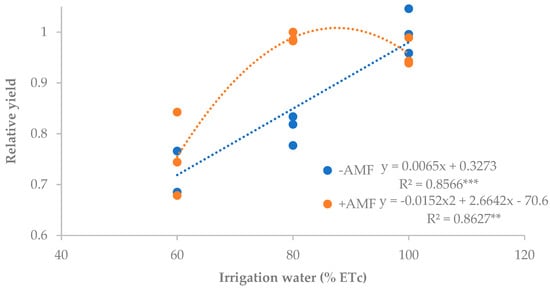
Figure 9.
Relationship between relative yield (yield/maximum yield) and irrigation water of inoculated (+AMF) and uninoculated (−AMF) melon plants during two years of experiments. ** significant at p < 0.01; *** significant at p < 0.001.
3.3. Fruit Characteristics
Unstressed plants produced the greatest and heaviest fruits (2405.0 g and 2479.4 mL on average), while the highest water stress (60% ETc) reduced significantly fruit weight and volume only in the uninoculated plants by 19.2 and 18.4%, respectively (Figure 10).
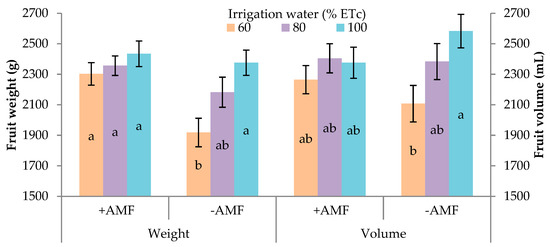
Figure 10.
Effect of irrigation treatments and plant inoculation with arbuscular mycorrhizal fungi (AMF) on melon fruit weight and volume during two years of experiments (for each interaction, bars with different letters are significantly different at p < 0.05 according to the LSD test).
Fruit size was mostly influenced by irrigation treatments (Table 4); fruit diameters were reduced significantly by water stress, decreasing from 159 mm (100% ETc) to 153 mm (60% ETc) in the case of the equatorial diameter (E), and from 239 mm (100% ETc) to 232 mm (60% ETc) in the case of the polar diameter (P). The latter was also affected by mycorrhizal inoculation, varying between 233 mm (+AMF) and 238 mm (−AMF). These modifications of fruit diameters did not affect the E/P ratio.
No significant variation due to the experimental treatments was recorded in rind thickness, edible part percentage, pulp color (data not presented), and titratable acidity (TA). Pulp firmness was significantly reduced (−10.4% on average) by the highest water stress (60% ETc), but was higher in fruit from inoculated plants than those of uninoculated plants (+8.3%) (Table 3). The interaction between irrigation and soil inoculation was significant for soluble solid content (SSC) and SSC/TA ratio (Figure 11). The uninoculated plants showed no significant variation of SSC or SSC/TA ratio as increasing water stress, whereas inoculated plants irrigated with 60% ETc increased significantly both parameters (+12.3% for SSC and +28.2% for SSC/TA). The ascorbic acid content of the fruits was also significantly influenced by the irrigation treatments, showing an increasing trend as increasing water stress, varying between 26.8 mg 100 g−1 f.w. to 67.5 mg 100 g−1 f.w. (Table 4).
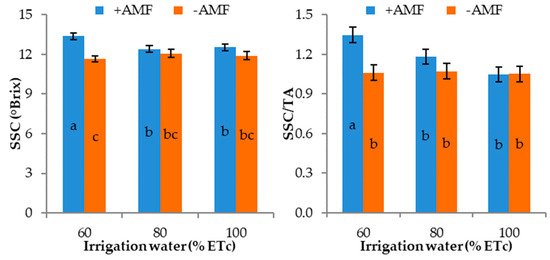
Figure 11.
Effect of irrigation treatments and plant inoculation with arbuscular mycorrhizal fungi (AMF) on soluble solid content (SSC) and soluble solid content: titratable acidity ratio (SSC/TA) of melon fruit during two years of experiments (for each parameter, bars with different letters are significantly different at p < 0.05 according to the LSD test).
3.4. Principal Component Analysis
The principal components analysis highlighted five principal components (PCs) with eigenvalues higher than 1.00 (Table 5), accounting for 47.95%, 22.86%, 14.60%, 8.65%, and 5.94% of the total variance, respectively. Thus, the initial twenty-six variables could be disclosed as a combination of five PCs, explaining 100% of the total variance.

Table 5.
Correlation of variables to the factors of the principal components analysis (PCA) based on the agronomic and yield quality characteristics of melon.
PC1 was mainly related to RWC, stomatal conductance, total, marketable and plant yield, fruit plant−1, NAE, fruit weight and volume, fruit diameters, firmness, and ascorbic acid content; PC2 was related to the MI, shoot length, unmarketable yield, IWUE, SSC, TA, SSC/TA ratio and hue; PC3 was related to the rind thickness, L* and chroma; PC4 was related to P/E ratio (Table 5). These relationships could be demonstrated by the projection of the original variables on the plane of the two PCs shown in the plot of loadings (Figure 12a). The discrimination of the irrigation regimes applied to inoculated or non-inoculated melon plants is reported in the plot of scores (Figure 12b), where the scores of each treatment are clearly separated. The scores of inoculated plants are located in the positive part of the PC2 axis while the scores of non-inoculated plants have lower values and are located in the negative part of the PC2 axis. The response of melon plants to increasing water stress differed between mycorrhized and non-mycorrhized ones, as the score of the inoculated plants decreased their PC1 to negative values only with 60% ETc while the score of the uninoculated plants had a negative value of PC1 for both 80% and 60% ETc. Combining the data from the plot of loadings and scores, it can be concluded that irrigation regimes influenced the melon plants in different ways according to the mycorrhizal inoculation (Figure 12a,b).
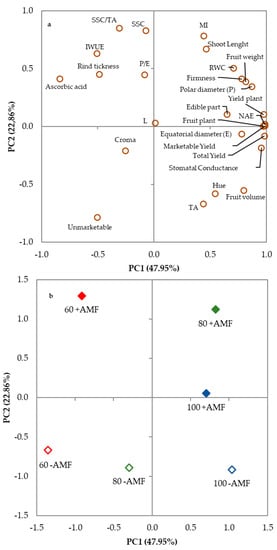
Figure 12.
Plot of (a) loadings (morphophysiological parameters, yield components, and fruit characteristics of melon, and (b) scores (trials) formed by the two principal components from the Principal Component Analysis (PCA). 60: irrigation with 60% ETc (red color); 80: irrigation with 80% ETc (green color); 100: irrigation with 100% ETc (blue color); +AMF: plants inoculated with arbuscular mycorrhizal fungi (full symbol); −AMF: plants not inoculated with arbuscular mycorrhizal fungi (empty symbol).
4. Discussion
The impact of AMF application under deficit irrigation regimes on the growth, yield, and quality of melon was studied for the first time in this two-year experiment. It is well-known that the growth and yield of many vegetable crops are limited by increasing water stress or reducing irrigation water quantities [49]. In both the years of the experiment, the total yield of the melon crop suffered the negative effect of deficit irrigation, recording a decrease of up to 23.4%, with the highest water stress (60% ETc). The results suggest that melon is not very susceptible to moderate water deficits in terms of total fruit yield whereas a water deficit of 20% of the ETc can significantly reduce melon marketable yield by 19.0%. These results are in agreement with those of Cabello et al. [42], who found a reduction in melon yield by 22% with a water deficit of 40% ETc, and those of Kirnak et al. [50], who recorded an even higher yield reduction (-50%) with a more severe water stress. Water deficit can determine various physiological changes in crops, such as stomata closure, reduced photosynthesis, and changes in plant water potential, that could lead to leaf damages [51]. Yield reductions recorded under drought stress conditions have been associated with changes in leaf water status, and reduced leaf chlorophyll and photosynthetic key enzymes and transpiration rate that could be mainly attributed to a decrease in stomatal conductance caused by stomatal closure [52,53,54]. Thus, the yield decrease under deficit irrigation conditions found in our work could be related to the physiological response of the uninoculated melon plants that linearly decreased the leaf RWC and stomatal conductance when increasing water stress. Moreover, we found a significant linear correlation (R2 = 0.991 ***) between RWC and stomatal conductance and between marketable yield and RWC (R2 = 0.988 ***) and stomatal conductance (R2 = 0.999 ***) confirming that the lower marketable yield recorded with deficit irrigation could be the result of a lower water and nutrient uptake from the soil and CO2 assimilation. It is well-known that photosynthesis is very sensitive to water shortages and that many crops suffer a reduction in their net photosynthetic rate when RWC drops down [34,55]. The negative effect of water deficit on melon yield could be also related to the reduction in nutrient solubility determined by the limitation of the soil water content, which reduces the uptake of nutrients by plants, thus limiting plant growth and resulting in a decrease in plant and fruit biomass accumulation [56]. The reduction in soil moisture in the rhizosphere can reduce the soil water potential which inhibits water and nutrients availability especially as regards nitrogen [57,58]
We also recorded that uninoculated plants modified the relationship between yield and irrigation water supplied only under severe drought (60% ETc) resulting in a higher (+18.8%) irrigation water use efficiency (IWUE) compared to control (100% ETc). An increase in water use efficiency under water stress conditions was also found in melon plants by Cabello et al., and Ribas et al., [42,59], and in other vegetables, such as watermelon [60], zucchini [61], eggplant [62], and bell pepper [63]. Under water stress conditions, plants wilt more than well-watered plants, and wilting occurs especially when the saturation deficit of the atmosphere is higher. Hence, the plant opens stomata and assimilates CO2 only when the saturation deficit is low, and water use efficiency increases because plants lose less water for every CO2 molecule fixed [64]. The nitrogen applied efficiency (NAE) was negatively affected by deficit irrigation as also found by Cabello et al. [42], who recorded a significant reduction in NAE reducing irrigation water from 100% ETc to 60% ETc. As stated before, water shortage in the rhizosphere hinders nitrogen uptake by also limiting water absorption. Many authors related the reduction in macronutrient uptake in many vegetable crops to the lower soil moisture content in the root zone under water stress conditions [50,62,65,66], and this could explicate the reduction in nitrogen fertilization efficiency under water stress.
The effect of deficit irrigation on yield components was more evident in fruit weight than fruit number as melon fruit weight is more sensitive to water stress than fruit number [66,67]. The reduction in fruit yield in drought treatments was related to a decrease in fruit weight. This confirms the results of other authors on the effect of deficit-irrigation treatments on melon yield components [17,42,59,66,67]. Moreover, a positive correlation between the volume of irrigation water supplied to melon plants and the fruit weight has been already reported [68].
Many vegetable crops suffer yield reduction due to water stress, but in many cases, they may also record improvements in fruit quality. In our study, the fruit quality of the uninoculated plants was slightly influenced by deficit irrigation treatments, only as regards fruit size (volume, width, and length), pulp firmness, and ascorbic acid content. Water shortage hinders the expansion and division of fruit flesh cells and the capacity to assimilate nutrients, thus lessening the single fruit weight and consequently also the total fruit yield [69]. A negative influence of deficit irrigation has already been reported on melon fruits that decrease their lengths by reducing the quantity of irrigation water [9]. As a result of increasing water stress, in our experiment the fruits reduced their size, but the aspect ratio, rind thickness, and edible part percentage did not change. These characteristics of melon fruits (as the pulp and rind ratios) are not usually influenced by the application of deficit irrigation [42,70,71]. Fruit firmness of the uninoculated plants was negatively affected only by the highest reduction in irrigation water (−14.7% compared to control). Barzegar et al. [72] reported the fruit firmness of melon fruit decreased as the irrigation was restricted, especially under high water stress conditions whereas other authors showed that increasing irrigation water to optimal irrigation can improve flesh firmness [42,73]. Fruit firmness is strictly linked to the calcium pectate accumulated in the cell wall; therefore, the reduction in this parameter could have been determined by a decrease in the uptake and translocation of calcium caused by the low water content in the soil [74]. Another positive effect of deficit irrigation on fruit quality was found in the ascorbic acid content which increased as increasing water stress. A similar trend was found by Sharma et al. [73] reducing irrigation water from 100% ETc to 50% ETc in three melon groups, and this agrees with the observation that water deficit during fruit growth and maturation may increase vitamin C content [75]. The increase in antioxidant activity is a defense response of plants to various abiotic stresses, such as drought stress. The mechanism of antioxidant production may vary according to many factors, such as genotype, environmental conditions, and stress severity and duration [76]. Crop management could also affect this parameter as an opposite trend of the ascorbic acid content was found in other experimental conditions [9,10,73,77].
The application of a mycorrhizal inoculum modified the response of melon plants to the water stress determined by deficit irrigation and a significant interaction between the deficit irrigation treatment and soil inoculation was found for some yield and quality parameters. The roots of melon plants from all trials, even those not inoculated, resulted infected with AMF. This confirmed the natural occurrence of indigenous communities of AMF in our experimental field [27]. This occurrence may vary according to soil conditions and plant presence. Natural ecosystems have a high diversity of mycorrhizal fungi communities compared with agricultural soils [78,79], especially high-input agricultural soils, which usually have a low infection potential together with a lower incidence of some AMF [80]. This could be ascribed to the low diversity of host plants, especially in monoculture crops [81], and to bare fallow periods when hosts are almost absent [82]. The uninoculated plants had a significantly lower mycorrhization index (MI) than the inoculated plants and, even if MI values did not vary significantly due to different irrigation treatments, their values followed a significant quadratic trend (R2 = 0.797 **) with the highest mycorrhization indexed expected with 87.9% ETc. The introduction of AMF by inoculating the commercial microbial biostimulant was successful in increasing root colonization at every irrigation water level but especially with 80% ETc; melon roots of the well-watered plants recorded colonization of 24.3%, similar to those recorded in watermelon seedlings and plants inoculated with mycorrhizal fungi from commercial formulations [27,83]. As found for uninoculated plants, the MI of inoculated plants followed a highly significant quadratic trend (R2 = 0.943 ***) with the highest expected mycorrhization indexed that could be obtained with 79.5% ETc. This trend could be explained by the relationship between soil moisture and mycorrhizal fungi growth and colonization which can be limited by both high and low soil moisture content. It was assessed that soil water contents approaching saturation can depress fungal growth in the rhizosphere and root infection by reducing soil void space and aeration [84,85,86], whereas drought stress can reduce the colonization of plants by AMF through the inhibition of spore germination, hyphae growth in soil, or hyphal spreading after initial infection [87,88,89,90].
The inoculation of crops with AMF can exert plant growth-enhancing effects on melon and many other plants grown under abiotic and biotic stress conditions [83,91,92]. As stated before, and as results from previous studies [93,94], RWC is negatively affected by deficit irrigation and drought stress, but AMF inoculation can increase plant tolerance to moderate water availability limitation. AMF increase the capacity of the roots to absorb water from the soil and improve water conductivity thanks to the increased water absorption area represented by the mycorrhizal hyphae. These perform an important role in the uptake and transport of water and nutrients from the soil to host plants under water stress conditions [95,96]. Furthermore, the hyphal network formed by AMF favors the formation of soil aggregates, thus increasing the volume of soil solution available to plants under drought stress [97]. Plants inoculated with AMF have proven to better modulate transpiration under water stress and, therefore, plants improve their water status and maintain a high relative water content even if grown in drought conditions [98]. AMF symbiosis may improve plant water status under drought stress by delaying leaf relative water content reduction and modifying shoot water content, thus allowing leaves to keep stomata open even at lower leaf RWC [99]. This agrees with our results that showed that mycorrhized plants suffered stomatal conductance reduction only at the highest water limitation and kept stomata more open than uninoculated plants with moderate deficit irrigation. The influence of AMF on stomatal opening has been linked to growth promotion under different water availability conditions [99,100]. This could be related to the higher photosynthetic rates recorded in AMF plants compared to non-mycorrhized plants, determined by increased stomatal conductance and transpiration due to P-mediated improvement in photosynthetic capacity and increased gas exchange [99,101]. The ability of AMF to improve plant growth and increase phosphorous availability and nutrient uptake has been already reported [102,103,104]. Huang et al. [87], in a trial where melon plants were inoculated with three Glomus spp., found a higher rate of gas exchange and growth improvements. The differences in plant growth between AMF plants and non-AMF plants are more significant in low fertility soil or under stress conditions [105] as also found in our experiment, where the main differences in yield and plant efficiency were recorded under moderate drought stress. The mycorrhizal inoculation did not significantly affect the total yield of melon fruit, but AMF had a positive effect on marketable yield under moderate deficit irrigation conditions thanks to the lower incidence of unmarketable fruit of the inoculated plants. An increase in marketable yield of mycorrhized plants was also found in watermelon and pepper under abiotic stress conditions [35,65]. Moreover, with severe deficit irrigation (60% ETc), AMF inoculation increased plant tolerance to drought stress determining a lower reduction in the average marketable fruit weight (−5.4%) compared to control plants (−19.2%). Fruit size is an important factor for fruit marketing; the reduction in fruit weight and size can affect both yield and fruit commercial value [106]. Water stress usually affect fruit development resulting in smaller fruit as also found in our experiment. AMF significantly decreased the percentage of small and unmarketable fruit probably thanks to the improved water status and nutrient uptake of the inoculated melon plants [106,107,108].
AMF inoculation has been proven to significantly improve melon fruit quality under commercial production conditions [109]. In our experiment, we also found this positive effect even under drought-stress conditions. Two of the characteristics that mostly affect the quality of melon fruits are pulp firmness and total soluble solids. Pulp firmness was higher in inoculated plants than uninoculated plants at every irrigation regime, whereas sugar content increased significantly as increasing water reduction only in AMF plants. The accumulation of soluble sugars in water stressed plants supplied with AMF has been documented in many species. The enhanced synthesis of osmolytes and sugar recorded in mycorrhized plants under water deficit stress may protect melon plants from the oxidative damages on protein and membranes determined by reactive oxygen species and lead to a significant increase in their accumulation [110]. Osmolyte accumulation in plant cells improve water uptake under drought stress [111] and may explain the growth-promoting effect of AMF on melon plants [112]. The inoculated plants also produced fruit with a higher value of SSC/TA (an important index of fruit flavor) than control plants with severe deficit irrigation, showing that these fruits had a better balance between fruit sweetness and acidity [27]. It was supposed that well-watered plants are less influenced by mycorrhizal inoculation [34], thus explaining the low differences in quality parameters recorded when plants received a sufficient amount of water, but we confirmed that AMF can increase the sugar content of melon fruit, especially under water deficit conditions [65,109,113].
The PCA analysis performed on yield, physiological, and quality parameters of melon plants summarizes the different responses of AMF and non-AMF plants to the different irrigation treatments. The first two components of the PCA account for 70.82% of the total variance observed in this study, thus overcoming the 25% of the total variance that is considered the lower limit to obtain accurate results and a good interpretation of the PCA [114]. The uninoculated plants showed to react to water shortage only with a negative relationship with all the parameters linked with PC1 (yield components, stomatal conductance, NAE), whereas the inoculated plants irrigated with 80% ETc counteracted water deficit keeping similar values of PC1 than the plants irrigated with 100% ETc but had higher values of PC2 (MI, RWC, fruit weight, and firmness) as the inoculated plants with 60% ETc that reduced their yield but had higher values of IWUE, SSC, and SSC/TA
5. Conclusions
To our knowledge this is the first published report showing the effects of the joined use of soil inoculation with AMF and deficit irrigation on melon plant, and fruit yield and quality. Water deficit negatively influenced melon plant physiology, yield components, and some quality parameters. Deficit irrigation allowed to save water (on average 843.1 or 1687.4 m3 ha−1 applying 80% ETc or 60% ETc), but with significant marketable yield reduction. AMF inoculated plants showed small differences compared to the uninoculated plants when grown under well-watered conditions (100% ETc), but resulted in higher drought tolerance. Thus, the combined use of moderate deficit irrigation (80% ETc) and soil inoculation with AMF could allow significant water savings without affecting fruit yield but increasing IWUE, NAE, and some quality characteristics (firmness, SSC, and SSC/TA). Furthermore, under water shortage conditions, such as in arid and semi-arid regions, the use of AMF-inoculated melon plants could be wort to reduce the yield loss and increase fruit quality even with severe deficit irrigation (60% ETc).
Author Contributions
Conceptualization, A.M. (Alessandro Miceli) and F.V.; Data curation, A.M. (Alessandro Miceli), F.V., and A.E.; Formal analysis, A.M. (Alessandro Miceli), L.T., and A.M. (Alessandra Moncada); Investigation, A.M. (Alessandro Miceli), F.V., L.T., and A.M. (Alessandra Moncada); Methodology, A.M. (Alessandro Miceli); Supervision, A.M. (Alessandro Miceli); Validation, A.M. (Alessandro Miceli) and A.M. (Alessandra Moncada); Writing—original draft, A.M. (Alessandro Miceli) and A.M. (Alessandra Moncada); Writing—review and editing, A.M. (Alessandro Miceli), L.T., A.E., and A.M. (Alessandro Miceli). All authors have read and agreed to the published version of the manuscript.
Funding
This research received no external funding.
Data Availability Statement
The data presented in this study are available in tables and figures.
Conflicts of Interest
The authors declare no conflict of interest.
References
- Jury, W.A.; Vaux, H., Jr. The role of science in solving the world’s emerging water problems. Proc. Natl. Acad. Sci. USA 2005, 102, 15715–15720. [Google Scholar] [CrossRef]
- Bogale, A.; Nagle, M.; Latif, S.; Aguila, M.; Müller, J. Regulated deficit irrigation and partial root-zone drying irrigation impact bioactive compounds and antioxidant activity in two select tomato cultivars. Sci. Hortic. 2016, 213, 115–124. [Google Scholar] [CrossRef]
- Moncada, A.; Vetrano, F.; Miceli, A. Alleviation of Salt Stress by Plant Growth-Promoting Bacteria in Hydroponic Leaf Lettuce. Agronomy 2020, 10, 1523. [Google Scholar] [CrossRef]
- Fereres, E.; Soriano, M.A. Deficit irrigation for reducing agricultural water use. J. Exp. Bot. 2007, 58, 147–159. [Google Scholar] [CrossRef]
- Rodriguez-Ramos, J.C.; Turini, T.; Wang, D.; Hale, L. Impacts of deficit irrigation and organic amendments on soil microbial populations and yield of processing tomatoes. Appl. Soil Ecol. 2022, 180, 104625. [Google Scholar] [CrossRef]
- Kuscu, H.; Turhan, A. Yield, Net Return and Fruit Quality Response of Melon to Deficit Irrigation. Gesunde Pflanz 2022, 74, 647–659. [Google Scholar] [CrossRef]
- Khapte, P.S.; Kumar, P.; Burman, U.; Kumar, P. Deficit irrigation in tomato: Agronomical and physio-biochemical implications. Sci. Hortic. 2019, 248, 256–264. [Google Scholar] [CrossRef]
- Geerts, S.; Raes, D. Deficit irrigation as an on-farm strategy to maximize crop water productivity in dry areas. Agric. Water Manag. 2009, 96, 1275–1284. [Google Scholar] [CrossRef]
- Zeng, C.Z.; Bie, Z.L.; Yuan, B.Z. Determination of optimum irrigation water amount for drip-irrigated muskmelon (Cucumis melo L.) in plastic greenhouse. Agric. Water Manag. 2009, 96, 595–602. [Google Scholar] [CrossRef]
- Wang, J.; Huang, G.; Li, J.; Zheng, J.; Huang, Q.; Liu, H. Effect of soil moisture-based furrow irrigation scheduling on melon (Cucumis melo L.) yield and quality in an arid region of Northwest China. Agric. Water Manag. 2017, 179, 167–176. [Google Scholar] [CrossRef]
- Bang, H.; Leskovar, D.I.; Bender, D.A.; Crosby, K. Deficit irrigation impact on lycopene, soluble solids, firmness and yield of diploid and triploid watermelon in three distinct environments. J. Hortic. Sci. Biotechnol. 2004, 79, 885–890. [Google Scholar] [CrossRef]
- Yildirim, O.; Halloran, N.; Çavuşoğlu, Ş.; Şengül, N. Effects of different irrigation programs on the growth, yield, and fruit quality of drip-irrigated melon. Turkish J. Agric. For. 2009, 33, 243–255. [Google Scholar] [CrossRef]
- Nangare, D.D.; Singh, Y.; Kumar, P.S.; Minhas, P.S. Growth, fruit yield and quality of tomato (Lycopersicon esculentum Mill.) as affected by deficit irrigation regulated on phenological basis. Agric. Water Manag. 2016, 171, 73–79. [Google Scholar] [CrossRef]
- Vetrano, F.; Fascella, S.; Moncada, A.; Incalcaterra, G. Testing various Sicilian melon landraces grown without irrigation. Italus Hortus 2010, 17, 97–98. [Google Scholar]
- Oweis, T.; Hachum, A. Water harvesting and supplemental irrigation for improved water productivity of dry farming systems in West Asia and North Africa. Agric. Water Manag. 2006, 80, 57–73. [Google Scholar] [CrossRef]
- Ali, M.H.; Hoque, M.R.; Hassan, A.A.; Khair, A. Effects of deficit irrigation on yield, water productivity, and economic returns of wheat. Agric. Water Manag. 2007, 92, 151–161. [Google Scholar] [CrossRef]
- Fabeiro, C.; Martín de Santa Olalla, F.; De Juan, J.A. Production of muskmelon (Cucumis melo L.) under controlled deficit irrigation in a semi-arid climate. Agric. Water Manag. 2002, 54, 93–105. [Google Scholar] [CrossRef]
- Jacoby, R.; Peukert, M.; Succurro, A.; Koprivova, A.; Kopriva, S. The role of soil microorganisms in plant mineral nutrition—Current knowledge and future directions. Front. Plant Sci. 2017, 8, 1617. [Google Scholar] [CrossRef]
- Lu, J.; Shao, G.; Cui, J.; Wang, X.; Keabetswe, L. Yield, fruit quality and water use efficiency of tomato for processing under regulated deficit irrigation: A meta-analysis. Agric. Water Manag. 2019, 222, 301–312. [Google Scholar] [CrossRef]
- Manzoni, S.; Schimel, J.P.; Porporato, A. Responses of soil microbial communities to water stress: Results from a meta-analysis. Ecology 2012, 93, 930–938. [Google Scholar] [CrossRef]
- Bastida, F.; Torres, I.F.; Romero-Trigueros, C.; Baldrian, P.; Větrovský, T.; Bayona, J.M.; Alarcón, J.J.; Hernández, T.; García, C.; Nicolás, E. Combined effects of reduced irrigation and water quality on the soil microbial community of a citrus orchard under semi-arid conditions. Soil Biol. Biochem. 2017, 104, 226–237. [Google Scholar] [CrossRef]
- Schimel, J.P. Life in dry soils: Effects of drought on soil microbial communities and processes. Annu. Rev. Ecol. Evol. Syst. 2018, 49, 409–432. [Google Scholar] [CrossRef]
- Hale, L.; Curtis, D.; Leon, N.; McGiffen, M., Jr.; Wang, D. Organic amendments, deficit irrigation, and microbial communities impact extracellular polysaccharide content in agricultural soils. Soil Biol. Biochem. 2021, 162, 108428. [Google Scholar] [CrossRef]
- Zhang, X.; Myrold, D.D.; Shi, L.; Kuzyakov, Y.; Dai, H.; Hoang, D.T.T.; Dippold, M.A.; Meng, X.; Song, X.; Li, Z. Resistance of microbial community and its functional sensitivity in the rhizosphere hotspots to drought. Soil Biol. Biochem. 2021, 161, 108360. [Google Scholar] [CrossRef]
- Hijri, M. Analysis of a large dataset of mycorrhiza inoculation field trials on potato shows highly significant increases in yield. Mycorrhiza 2016, 26, 209–214. [Google Scholar] [CrossRef]
- Reid, A.; Greene, S.E. How Microbes Can Help Feed the World: Report on an American Academy of Microbiology Colloquium Washington, DC//December 2012. Am. Soc. Microbiol. 2012, 1–36. Available online: https://www.ncbi.nlm.nih.gov/books/NBK559436/ (accessed on 29 November 2022).
- Miceli, A.; Romano, C.; Moncada, A.; Piazza, G.; Torta, L.; D’Anna, F.; Vetrano, F. Yield and quality of mini-watermelon as affected bygrafting and mycorrhizal inoculum. J. Agric. Sci. Technol. 2016, 18, 505–516. [Google Scholar]
- Redecker, D.; Kodner, R.; Graham, L.E. Glomalean fungi from the Ordovician. Science 2000, 289, 1920–1921. [Google Scholar] [CrossRef]
- Bona, E.; Cantamessa, S.; Massa, N.; Manassero, P.; Marsano, F.; Copetta, A.; Lingua, G.; D’Agostino, G.; Gamalero, E.; Berta, G. Arbuscular mycorrhizal fungi and plant growth-promoting pseudomonads improve yield, quality and nutritional value of tomato: A field study. Mycorrhiza 2017, 27, 1–11. [Google Scholar] [CrossRef]
- Bowles, T.M.; Barrios-Masias, F.H.; Carlisle, E.A.; Cavagnaro, T.R.; Jackson, L.E. Effects of arbuscular mycorrhizae on tomato yield, nutrient uptake, water relations, and soil carbon dynamics under deficit irrigation in field conditions. Sci. Total Environ. 2016, 566, 1223–1234. [Google Scholar] [CrossRef]
- Poulton, J.L.; Bryla, D.; Koide, R.T.; Stephenson, A.G. Mycorrhizal infection and high soil phosphorus improve vegetative growth and the female and male functions in tomato. New Phytol. 2002, 154, 255–264. [Google Scholar] [CrossRef]
- Gianinazzi, S.G. Domestication of beneficial soil microorganisms: An innovative technology for agriculture. In Proceedings of the International Congress on Mycorrhizae, Marrakesh, Morocco, 15–17 October 2014; p. 26. [Google Scholar]
- Nzanza, B.; Marais, D.; Soundy, P. Yield and nutrient content of tomato (Solanum lycopersicum L.) as influenced by Trichoderma harzianum and Glomus mosseae inoculation. Sci. Hortic. 2012, 144, 55–59. [Google Scholar] [CrossRef]
- Yang, P.; He, S. The effects of arbuscular mycorrhizal fungi and deficit irrigation on the yield and sugar content of watermelons (Citrullus lanatus). Hortic. Sci. 2022, 49, 225–233. [Google Scholar] [CrossRef]
- Kaya, C.; Ashraf, M.; Sonmez, O.; Aydemir, S.; Tuna, A.L.; Cullu, M.A. The influence of arbuscular mycorrhizal colonisation on key growth parameters and fruit yield of pepper plants grown at high salinity. Sci. Hortic. 2009, 121, 1–6. [Google Scholar] [CrossRef]
- Smith, S.E.; Smith, F.A. Roles of arbuscular mycorrhizas in plant nutrition and growth: New paradigms from cellular to ecosystem scales. Annu. Rev. Plant Biol. 2011, 62, 227–250. [Google Scholar] [CrossRef]
- Smith, S.E.; Jakobsen, I.; Grønlund, M.; Smith, F.A. Roles of arbuscular mycorrhizas in plant phosphorus nutrition: Interactions between pathways of phosphorus uptake in arbuscular mycorrhizal roots have important implications for understanding and manipulating plant phosphorus acquisition. Plant Physiol. 2011, 156, 1050–1057. [Google Scholar] [CrossRef]
- Higo, M.; Azuma, M.; Kamiyoshihara, Y.; Kanda, A.; Tatewaki, Y.; Isobe, K. Impact of phosphorus fertilization on tomato growth and arbuscular mycorrhizal fungal communities. Microorganisms 2020, 8, 178. [Google Scholar] [CrossRef]
- Doorenbos, J.; Pruitt, W.O. Crop Water Requirements; Irrig. Drain. Pap. No. 24; FAO: Rome, Italy, 1974. [Google Scholar]
- Allen, R.G.; Pereira, L.S.; Raes, D.; Smith, M. Crop Evapotranspiration: Guidelines for Computing Crop Requirements; Irrig. Drain. Pap. No. 56; FAO: Rome, Italy, 1998. [Google Scholar]
- Smith, M. CROPWAT, a Computer Program for Irrigation Planning and Management; FAO Irrigation and Drainage Publications No 46; FAO: Rome, Italy, 1992. [Google Scholar]
- Cabello, M.J.; Castellanos, M.T.; Romojaro, F.; Martínez-Madrid, C.; Ribas, F. Yield and quality of melon grown under different irrigation and nitrogen rates. Agric. Water Manag. 2009, 96, 866–874. [Google Scholar] [CrossRef]
- Miceli, A.; Vetrano, F.; Moncada, A. Effects of Foliar Application of Gibberellic Acid on the Salt Tolerance of Tomato and Sweet Pepper Transplants. Horticulturae 2020, 6, 93. [Google Scholar] [CrossRef]
- Moncada, A.; Vetrano, F.; Esposito, A.; Miceli, A. Fertigation Management and Growth-Promoting Treatments Affect Tomato Transplant Production and Plant Growth after Transplant. Agronomy 2020, 10, 1504. [Google Scholar] [CrossRef]
- Vetrano, F.; Miceli, C.; Angileri, V.; Frangipane, B.; Moncada, A.; Miceli, A. Effect of Bacterial Inoculum and Fertigation Management on Nursery and Field Production of Lettuce Plants. Agronomy 2020, 10, 1477. [Google Scholar] [CrossRef]
- Phillips, J.M.; Hayman, D.S. Improved procedures for clearing roots and staining parasitic and vesicular-arbuscular mycorrhizal fungi for rapid assessment of infection. Trans. Br. Mycol. Soc. 1970, 55, 158–IN18. [Google Scholar] [CrossRef]
- Rajapakse, S.; Miller, J.C. Methods for Studying Vesicular-arbuscular Mycorrhizal Root Colonization and Related Root Physical Properties. Methods Microbiol. 1992, 24, 301–316. [Google Scholar] [CrossRef]
- Liguori, G.; Gaglio, R.; Settanni, L.; Inglese, P.; D’Anna, F.; Miceli, A. Effect of Opuntia ficus-indica Mucilage Edible Coating in Combination with Ascorbic Acid, on Strawberry Fruit Quality during Cold Storage. J. Food Qual. 2021, 2021, 9976052. [Google Scholar] [CrossRef]
- Chaves, M.M.; Maroco, J.P.; Pereira, J.S. Understanding plant responses to drought—From genes to the whole plant. Funct. Plant Biol. 2003, 30, 239. [Google Scholar] [CrossRef]
- Kirnak, H.; Higgs, D.; Kaya, C.; Tas, I. Effects of Irrigation and Nitrogen Rates on Growth, Yield, and Quality of Muskmelon in Semiarid Regions. J. Plant Nutr. 2005, 28, 621–638. [Google Scholar] [CrossRef]
- Hong, T.; Cai, Z.; Li, R.; Liu, J.; Li, J.; Wang, Z.; Zhang, Z. Effects of water and nitrogen coupling on watermelon growth, photosynthesis and yield under CO2 enrichment. Agric. Water Manag. 2022, 259, 107229. [Google Scholar] [CrossRef]
- Rouphael, Y.; Cardarelli, M.; Colla, G.; Rea, E. Yield, Mineral Composition, Water Relations, and Water Use Efficiency of Grafted Mini-watermelon Plants Under Deficit Irrigation. HortScience 2008, 43, 730–736. [Google Scholar] [CrossRef]
- Bencze, S.; Bamberger, Z.; Janda, T.; Balla, K.; Varga, B.; Bedő, Z.; Veisz, O. Physiological response of wheat varieties to elevated atmospheric CO 2 and low water supply levels. Photosynthetica 2014, 52, 71–82. [Google Scholar] [CrossRef]
- Sun, G.; Liu, X.; Yu, X.; Peng, Y.; Leng, X.; Huang, Y.; Yang, Q. Effects of moistube patterns and fertilization levels on growth and physiological characteristics of blueberry. Chin. J. Ecol. 2019, 38, 604. [Google Scholar]
- Dias, M.C.; Brüggemann, W. Differential inhibition of photosynthesis under drought stress in Flaveria species with different degrees of development of the C4 syndrome. Photosynthetica 2007, 45, 75–84. [Google Scholar] [CrossRef]
- Niu, Y.H.; Cao, H.X.; Shi, X.H.; Wang, X.M. Effects of water deficit on growth-development and physiological characteristics of greenhouse tomato. J. Irrig. Drain. 2013, 32, 67–70. [Google Scholar]
- Li, H.; Liu, H.; Pang, J.; Li, S.; Cui, Y.; Sun, J. Effects of water and nitrogen interaction on growth and nutrient accumulation of potted tomatoes. Trans. Chin. Soc. Agric. Mach. 2019, 50, 272–279. [Google Scholar]
- Wang, Y.; Liu, F.; Jensen, L.S.; de Neergaard, A.; Jensen, C.R. Alternate partial root-zone irrigation improves fertilizer-N use efficiency in tomatoes. Irrig. Sci. 2013, 31, 589–598. [Google Scholar] [CrossRef]
- Ribas, F.; Cabello, M.J.; Moreno, M.M.; Moreno, A.; López-Bellido, L. Influencia del riego y de la aplicación de potasio en la producción del melón (Cucumis melo L.). I: Rendimiento. Invest. Agric. Prod. Prot. Veg. 2001, 16, 283–297. [Google Scholar]
- Sçimsçek, M.; Kacçura, M.; Tonkaz, T. The effects of different irrigation regimes on watermelon [Citrillus lanatus (Thunb.)] yield and yield components under semi-arid climatic conditions. Aust. J. Agric. Res 2004, 55, 1149–1157. [Google Scholar] [CrossRef]
- Zotarelli, L.; Dukes, M.D.; Scholberg, J.M.; Hanselman, T.; Le Femminella, K.; Munoz-Carpena, R. Nitrogen and water use efficiency of zucchini squash for a plastic mulch bed system on a sandy soil. Sci. Hortic. 2008, 116, 8–16. [Google Scholar] [CrossRef]
- Kirnak, H.; Tas, I.; Kaya, C.; Higgs, D. Effects of deficit irrigation on growth, yield and fruit quality of eggplant under semi-arid conditions. Aust. J. Agric. Res. 2002, 53, 1367–1373. [Google Scholar] [CrossRef]
- Dalla Costa, L.; Gianquinto, G. Water stress and watertable depth influence yield, water use efficiency, and nitrogen recovery in bell pepper: Lysimeter studies. Aust. J. Agric. Res. 2002, 53, 201–210. [Google Scholar] [CrossRef]
- Bloch, D.; Hoffmann, C.M.; Märländer, B. Impact of water supply on photosynthesis, water use and carbon isotope discrimination of sugar beet genotypes. Eur. J. Agron. 2006, 24, 218–225. [Google Scholar] [CrossRef]
- Kaya, C.; Higgs, D.; Kirnak, H.; Tas, I. Mycorrhizal colonisation improves fruit yield and water use efficiency in watermelon (Citrullus lanatus Thunb.) grown under well-watered and water-stressed conditions. Plant Soil 2003, 253, 287–292. [Google Scholar] [CrossRef]
- Dogan, E.; Kirnak, H.; Berekatoglu, K.; Bilgel, L.; Surucu, A. Water stress imposed on muskmelon (Cucumis melo L.) with subsurface and surface drip irrigation systems under semi-arid climatic conditions. Irrig. Sci. 2008, 26, 131–138. [Google Scholar] [CrossRef]
- Long, R.L.; Walsh, K.B.; Midmore, D.J.; Rogers, G. Irrigation scheduling to increase muskmelon fruit biomass and soluble solids concentration. HortScience 2006, 41, 367–369. [Google Scholar] [CrossRef]
- Al-Mefleh, N.K.; Samarah, N.; Zaitoun, S.; Al-Ghzawi, A. Effect of irrigation levels on fruit characteristics, total fruit yield and water use efficiency of melon under drip irrigation system. J. Food Agric. Environ. 2012, 10, 540–545. [Google Scholar]
- Liu, X.; Peng, Y.; Yang, Q.; Wang, X.; Cui, N. Determining optimal deficit irrigation and fertilization to increase mango yield, quality, and WUE in a dry hot environment based on TOPSIS. Agric. Water Manag. 2021, 245, 106650. [Google Scholar] [CrossRef]
- Ribas, F.; Cabello, M.J.; Moreno, M.M.; Moreno, A.; López-Bellido, L. Effect of irrigation and potassium application in melon (Cucumis melo L.) production. II: Quality. Span. J. Agric. Res. 2003, 1, 79. [Google Scholar] [CrossRef]
- Leite, V.M.; Rosolem, C.A.; Rodrigues, J.D. Gibberellin and cytokinin effects on soybean growth. Sci. Agric. 2005, 60, 537–541. [Google Scholar] [CrossRef]
- Barzegar, T.; Heidaryan, N.; Lotfi, H.; Ghahremani, Z. Yield, fruit quality and physiological responses of melon cv. Khatooni under deficit irrigation. Adv. Hortic. Sci. 2018, 32, 451–458. [Google Scholar]
- Sharma, S.P.; Leskovar, D.I.; Crosby, K.M.; Volder, A.; Ibrahim, A.M.H. Root growth, yield, and fruit quality responses of reticulatus and inodorus melons (Cucumis melo L.) to deficit subsurface drip irrigation. Agric. Water Manag. 2014, 136, 75–85. [Google Scholar] [CrossRef]
- Olguín, M.A.V.; De la Fuente, M.C.; Mendoza, A.B.; Maldonado, A.J.; Rangel, A.S.; Cusimamani, E.F. Commercial and nutraceutical quality of grafted melon cultivated under hydric stress. Hortic. Sci. 2020, 47, 139–149. [Google Scholar] [CrossRef]
- Cui, N.; Du, T.; Kang, S.; Li, F.; Zhang, J.; Wang, M.; Li, Z. Regulated deficit irrigation improved fruit quality and water use efficiency of pear-jujube trees. Agric. Water Manag. 2008, 95, 489–497. [Google Scholar] [CrossRef]
- Barzegar, T.; Lotfi, H.; Rabiei, V.; Ghahremani, Z.; Nikbakht, J. Effect of water-deficit stress on fruit yield, antioxidant activity, and some physiological traits of four Iranian melon genotypes. Iran. J. Hortic. Sci. 2017, 48, 13–25. [Google Scholar] [CrossRef]
- Li, Y.-J.; Yuan, B.-Z.; Bie, Z.-L.; Kang, Y. Effect of drip irrigation criteria on yield and quality of muskmelon grown in greenhouse conditions. Agric. Water Manag. 2012, 109, 30–35. [Google Scholar] [CrossRef]
- Talukdar, N.C.; Germida, J.J. Occurrence and isolation of vesicular–arbuscular mycorrhizae in cropped field soils of Saskatchewan, Canada. Can. J. Microbiol. 1993, 39, 567–575. [Google Scholar] [CrossRef]
- Błaszkowski, J. Comparative studies of the occurrence of arbuscular fungi and mycorrhizae (Glomales) in cultivated and uncultivated soils of Poland. Acta Mycol. 2014, 28, 93–140. [Google Scholar] [CrossRef]
- Douds, D.D.; Janke, R.R.; Peters, S.E. VAM fungus spore populations and colonization of roots of maize and soybean under conventional and low-input sustainable agriculture. Agric. Ecosyst. Environ. 1993, 43, 325–335. [Google Scholar] [CrossRef]
- Gosling, P.; Hodge, A.; Goodlass, G.; Bending, G.D. Arbuscular mycorrhizal fungi and organic farming. Agric. Ecosyst. Environ. 2006, 113, 17–35. [Google Scholar] [CrossRef]
- Lekberg, Y.; Koide, R.T. Is plant performance limited by abundance of arbuscular mycorrhizal fungi? A meta-analysis of studies published between 1988 and 2003. New Phytol. 2005, 168, 189–204. [Google Scholar] [CrossRef]
- Westphal, A.; Snyder, N.L.; Xing, L.; Camberato, J.J. Effects of Inoculations with Mycorrhizal Fungi of Soilless Potting Mixes During Transplant Production on Watermelon Growth and Early Fruit Yield. HortScience 2008, 43, 354–360. [Google Scholar] [CrossRef]
- Theodorou, C. Soil moisture and the mycorrhizal association of Pinus radiata D. don. Soil Biol. Biochem. 1978, 10, 33–37. [Google Scholar] [CrossRef]
- Boucher, N.L.; Malajczuk, N. Effects of high soil moisture on formation of ectomycorrhizas and growth of karri (Eucalyptus diversicolor) seedlings inoculated with Descolea maculata, Pisolithus tinctorius and Laccaria laccata. New Phytol. 1990, 114, 87–91. [Google Scholar] [CrossRef]
- Barnes, C.J.; van der Gast, C.J.; McNamara, N.P.; Rowe, R.; Bending, G.D. Extreme rainfall affects assembly of the root-associated fungal community. New Phytol. 2018, 220, 1172–1184. [Google Scholar] [CrossRef]
- Huang, Z.; Zou, Z.; He, C.; He, Z.; Zhang, Z.; Li, J. Physiological and photosynthetic responses of melon (Cucumis melo L.) seedlings to three Glomus species under water deficit. Plant Soil 2011, 339, 391–399. [Google Scholar] [CrossRef]
- Jacobson, K.M. Moisture and substrate stability determine VA-mycorrhizal fungal community distribution and structure in an arid grassland. J. Arid Environ. 1997, 35, 59–75. [Google Scholar] [CrossRef]
- Estaun, M.V. Effect of sodium chloride and mannitol on germination and hyphal growth of the vesicular-arbuscular mycorrhizal fungus Glomus mosseae. Agric. Ecosyst. Environ. 1990, 29, 123–129. [Google Scholar] [CrossRef]
- Bolgiano, N.C.; Safir, G.R.; Warncke, D.D. Mycorrhizal infection and growth of onion in the field in relation to phosphorus and water availability. J. Am. Soc. Hortic. Sci. 1983, 108, 819–825. [Google Scholar] [CrossRef]
- Sensoy, S.; Demir, S.; Tufenkci, S.; Erdinç, C.; Demirer, E.; Unsal, H.; Halifeoglu, G.; Ekincialp, A. Response of four zucchini (Cucurbita pepo L.) hybrids to different arbuscular mycorrhizal fungi. J. Anim. Plant Sci. 2011, 21, 31. [Google Scholar]
- Abdel Latef, A.A. Growth and some physiological activities of pepper (Capsicum annuum L.) in response to cadmium stress and mycorrhizal symbiosis. J. Agric. Sci. Technol. 2013, 15, 1437–1448. [Google Scholar]
- Zhao, R.; Guo, W.; Bi, N.; Guo, J.; Wang, L.; Zhao, J.; Zhang, J. Arbuscular mycorrhizal fungi affect the growth, nutrient uptake and water status of maize (Zea mays L.) grown in two types of coal mine spoils under drought stress. Appl. Soil Ecol. 2015, 88, 41–49. [Google Scholar] [CrossRef]
- Subramanian, K.S.; Santhanakrishnan, P.; Balasubramanian, P. Responses of field grown tomato plants to arbuscular mycorrhizal fungal colonization under varying intensities of drought stress. Sci. Hortic. 2006, 107, 245–253. [Google Scholar] [CrossRef]
- Bitterlich, M.; Franken, P.; Graefe, J. Arbuscular Mycorrhiza Improves Substrate Hydraulic Conductivity in the Plant Available Moisture Range Under Root Growth Exclusion. Front. Plant Sci. 2018, 9, 301. [Google Scholar] [CrossRef] [PubMed]
- Quiroga, G.; Erice, G.; Aroca, R.; Zamarreño, Á.M.; García-Mina, J.M.; Ruiz-Lozano, J.M. Radial water transport in arbuscular mycorrhizal maize plants under drought stress conditions is affected by indole-acetic acid (IAA) application. J. Plant Physiol. 2020, 246–247, 153115. [Google Scholar] [CrossRef] [PubMed]
- Sun, D.; Li, K.; Bi, Q.; Zhu, J.; Zhang, Q.; Jin, C.; Lu, L.; Lin, X. Effects of organic amendment on soil aggregation and microbial community composition during drying-rewetting alternation. Sci. Total Environ. 2017, 574, 735–743. [Google Scholar] [CrossRef]
- Liu, C.; Ravnskov, S.; Liu, F.; Rubæk, G.H.; Andersen, M.N. Arbuscular mycorrhizal fungi alleviate abiotic stresses in potato plants caused by low phosphorus and deficit irrigation/partial root-zone drying. J. Agric. Sci. 2018, 156, 46–58. [Google Scholar] [CrossRef]
- Augé, R.M. Water relations, drought and vesicular-arbuscular mycorrhizal symbiosis. Mycorrhiza 2001, 11, 3–42. [Google Scholar] [CrossRef]
- Ruiz-Lozano, J.M.; Azcon, R.; Gomez, M. Effects of arbuscular-mycorrhizal glomus species on drought tolerance: Physiological and nutritional plant responses. Appl. Environ. Microbiol. 1995, 61, 456–460. [Google Scholar] [CrossRef] [PubMed]
- Koide, R.T. Nutrient supply, nutrient demand and plant response to mycorrhizal infection. New Phytol. 1991, 117, 365–386. [Google Scholar] [CrossRef]
- Ames, R.N.; Reid, C.P.P.; Porter, L.K.; Cambardella, C. Hyphal uptake and transport of nitrogen from two 15n-labelled sources by glomus mosseae, a vesicular-arbuscular mycorrhizal fungus. New Phytol. 1983, 95, 381–396. [Google Scholar] [CrossRef]
- Zuccarini, P. Mycorrhizal infection ameliorates chlorophyll content and nutrient uptake of lettuce exposed to saline irrigation. Plant Soil Environ. 2008, 53, 283–289. [Google Scholar] [CrossRef]
- Tawaraya, K.; Naito, M.; Wagatsuma, T. Solubilization of Insoluble Inorganic Phosphate by Hyphal Exudates of Arbuscular Mycorrhizal Fungi. J. Plant Nutr. 2006, 29, 657–665. [Google Scholar] [CrossRef]
- Martínez-Medina, A.; Roldán, A.; Albacete, A.; Pascual, J.A. The interaction with arbuscular mycorrhizal fungi or Trichoderma harzianum alters the shoot hormonal profile in melon plants. Phytochemistry 2011, 72, 223–229. [Google Scholar] [CrossRef]
- Kays, S.J. Preharvest factors affecting appearance. Postharvest Biol. Technol. 1999, 15, 233–247. [Google Scholar] [CrossRef]
- Tshibangu Kazadi, A.; Lwalaba wa Lwalaba, J.; Kirika Ansey, B.; Mavungu Muzulukwau, J.; Manda Katabe, G.; Iband Karul, M.; Baert, G.; Haesaert, G.; Mukobo Mundende, R.-P. Effect of Phosphorus and Arbuscular Mycorrhizal Fungi (AMF) Inoculation on Growth and Productivity of Maize (Zea mays L.) in a Tropical Ferralsol. Gesunde Pflanz. 2022, 74, 159–165. [Google Scholar] [CrossRef]
- Mathur, S.; Tomar, R.S.; Jajoo, A. Arbuscular Mycorrhizal fungi (AMF) protects photosynthetic apparatus of wheat under drought stress. Photosynth. Res. 2019, 139, 227–238. [Google Scholar] [CrossRef] [PubMed]
- Copetta, A.; Todeschini, V.; Massa, N.; Bona, E.; Berta, G.; Lingua, G. Inoculation with arbuscular mycorrhizal fungi improves melon (Cucumis melo) fruit quality under field conditions and plant performance in both field and greenhouse. Plant Biosyst. Int. J. Deal. All Asp. Plant Biol. 2021, 155, 1063–1074. [Google Scholar] [CrossRef]
- Hashem, A.; Abd_Allah, E.F.; Alqarawi, A.A.; Egamberdieva, D. Bioremediation of adverse impact of cadmium toxicity on Cassia italica Mill by arbuscular mycorrhizal fungi. Saudi J. Biol. Sci. 2016, 23, 39–47. [Google Scholar] [CrossRef]
- Begum, N.; Ahanger, M.A.; Su, Y.; Lei, Y.; Mustafa, N.S.A.; Ahmad, P.; Zhang, L. Improved Drought Tolerance by AMF Inoculation in Maize (Zea mays) Involves Physiological and Biochemical Implications. Plants 2019, 8, 579. [Google Scholar] [CrossRef]
- Mo, Y.; Wang, Y.; Yang, R.; Zheng, J.; Liu, C.; Li, H.; Ma, J.; Zhang, Y.; Wei, C.; Zhang, X. Regulation of Plant Growth, Photosynthesis, Antioxidation and Osmosis by an Arbuscular Mycorrhizal Fungus in Watermelon Seedlings under Well-Watered and Drought Conditions. Front. Plant Sci. 2016, 7, 644. [Google Scholar] [CrossRef]
- Alarcón, A.L.; Gómez-Bellot, M.J.; Bernabe, A.J.; Calvo, G.; Fernández Martín, F. Changes in root architecture and productivity of melon (Cucumis melo L. cv. Hispano Nunhems) promoted by Glomus iranicum var. tenuihypharum. J. Hortic. Sci. Biotechnol. 2020, 95, 364–373. [Google Scholar] [CrossRef]
- Mohammadi, S.A.; Prasanna, B.M. Analysis of Genetic Diversity in Crop Plants—Salient Statistical Tools and Considerations. Crop Sci. 2003, 43, 1235–1248. [Google Scholar] [CrossRef]
Disclaimer/Publisher’s Note: The statements, opinions and data contained in all publications are solely those of the individual author(s) and contributor(s) and not of MDPI and/or the editor(s). MDPI and/or the editor(s) disclaim responsibility for any injury to people or property resulting from any ideas, methods, instructions or products referred to in the content. |
© 2023 by the authors. Licensee MDPI, Basel, Switzerland. This article is an open access article distributed under the terms and conditions of the Creative Commons Attribution (CC BY) license (https://creativecommons.org/licenses/by/4.0/).